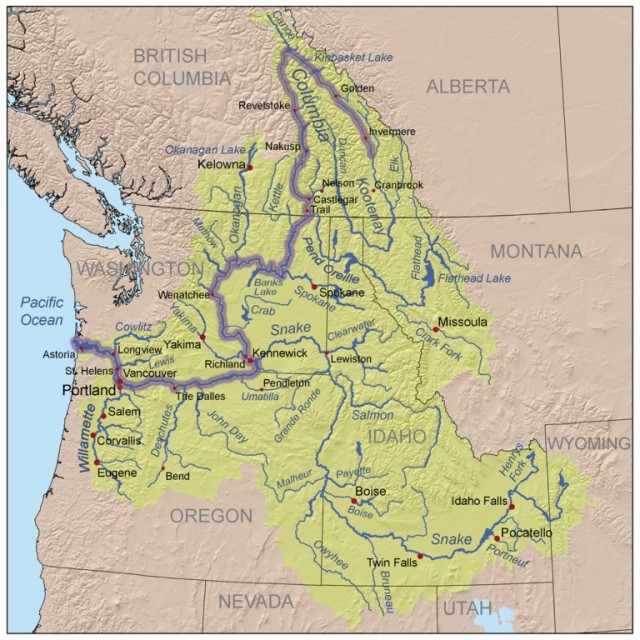Canoe journey spotlights plight of Columbia salmon
Episode 1: The Fish Ladder from Voyages of Rediscovery on Vimeo.
RIVERS -- An expedition of canoeists and Native American students is leading an upstream effort to advocate construction of a fish ladder to reintroduce chinook salmon runs in the Columbia River above Grand Coulee Dam.

On Aug. 2, five salmon-inspired dugout canoes started their journey up the Columbia River to pay tribute to the salmon no longer able to reach their historic spawning grounds of the Upper Columbia River since the construction of Grand Coulee Dam.
The boats have made it past Chief Joseph Dam last week, paddled up Lake Rufus Woods and completed the portage around Grand Coulee Dam on Saturday. They expected to paddle up Lake Roosevelt to Keller Ferry by Saturday night and then leave there today, headed for Two Rivers at the mouth of the Spokane River by Monday night.
From the confluence of the Spokane and Columbia Rivers, the paddlers will head up the Spokane River to Little Falls -- the first dam that blocked salmon from migrating up to Spokane Falls in 1910. Spokane Tribe schoolkids (who helped build one of the dugout canoes) will join the paddle. A public event of some sort is planned at the end of the week. See blog updates here.
The “Sea to the Source” expedition left Astoria, Ore., in an upstream voyage toward Canal Flats, the source of the Columbia River in British Columbia.
The crew consists of five river guides who oversee a river-based environmental education program called Voyages of Rediscovery. They are enlisting the muscle power of Indian Tribes, youths and other supporters along the way.
“The idea behind the canoes and the river expedition is to bring the salmon back to the upper reaches of the Columbia River,” said Adam Wicks-Arshack a guide with Voyages of Rediscovery and environmental educator. “We carved these canoes with thousands of students who’ve had the salmon removed from their culture by Grand Coulee Dam.”

The five dugout canoes were carved at various schools over the past year. For most of the trip they have been paddling two canoes, the “Salmon Savior” a 21-foot ponderosa pine, carved at the Wellpinit Middle and High School on the Spokane Reservation and a larger 33-foot cedar canoe, the “Crying Salmon,” which was carved by the students of Inchelium School on the Colville Reservation.
As the expedition arrives at each school that carved a canoe, Inchelium, Wellpinit, Kettle Falls, and Medicine Wheel Academy of the Community School in Spokane, the canoes will be gifted back to the school and young people who carved them.
“These canoes represent the Salmon,” said Xander Demetrios, a river guide with the expedition. “They have traveled through many hardships from the Pacific Ocean and are nearing their former Spawning Grounds. These will be the first salmon to pass Chief Joe and Grand Coulee in a long time.”
The expedition has canoed more than 545 miles up the Columbia River to Chief Joseph Dam, the first dam without a fish ladder and is approaching Grand Coulee Dam.
The river guides and environmental educators anticipate another 1-2 weeks of paddling to reach the international border between the United States and Canada.
John Zinser, boat builder and river guide, proudly praises the young carvers (see video above). “The students worked every day on these canoes and it is an honor to paddle these salmon canoes which were created with so much energy from so many young people,” he said.

When the expedition arrives at each school the crew is giving presentations about their journey and the importance of salmon and the Columbia River. Most importantly each student will have the opportunity to paddle in the canoes they carved.
This expedition comes in the midst of preparations by the United States and Canada to renegotiate the Columbia River Treaty that governs one of the great rivers of the world. The 1964 Treaty failed to consult with Tribes, First Nations, and the residents of southern British Columbia. The Treaty built 3 treaty dams in British Columbia and the Libby Dam in northwestern Montana, forcing 2000 people from their homes. The Treaty contains only the two purposes of hydropower and flood control.
Tribes and conservationists want a third purpose added to the Treaty: restoring the Columbia River to ecological health including bringing salmon home to waters blocked by dams.
“The Grand Coulee Dam was once considered to be the greatest engineering project the world had ever seen,” noted Wicks-Arshack. “Now let's get started with the greatest eco-engineering project—a fish ladder at the Grand Coulee Dam.”

Voyages of Rediscovery is a program of The River School, a non-profit river based environmental education not for profit. They have been offering educational canoe trips and canoe building opportunities on the Columbia River for the past five years. If you would like to follow the Sea2Source expedition, you can follow their blog and/or facebook page.
